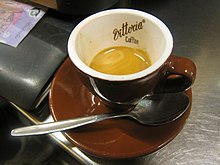Ristretto (Italian: [risˈtretto])[1] is a "short shot" (20 ml (0.7 imp fl oz; 0.7 US fl oz) from a double basket) of a more highly concentrated espresso coffee. It is made with the same amount of ground coffee, but extracted with a finer grind (also in from 20 to 30 seconds) using half as much water. A normal short shot might look like a ristretto, but in reality, would only be a weaker, more diluted, shot.[2] The opposite of a ristretto (Italian for 'shortened', 'narrow') is a lungo ('long'), which has double the amount of water. The French call a ristretto a café serré.[3]


Regardless of whether one uses a hand pressed machine or an automatic, a regular double shot is generally considered to be around 14–18 g (0.49–0.63 oz) of ground coffee extracted into about 40 ml (2 fl oz; two shot glasses).[4] Thus, a "double ristretto" consumes the same amount of coffee beans but fills only a single shot glass.
Coffee contains over a thousand aromatic compounds.[5] A ristretto's chemical composition and taste differ from those of a full-length extraction for three reasons:
Straight ristrettos—shots that are traditionally drunk from a demitasse and not diluted into a larger cup containing milk or water—could be described as bolder, fuller, with more body and less bitterness. These characteristics are usually attributed to espresso in general but are more pronounced in a ristretto. Diluted into a cup of water (e.g. americanoorlong black) or milk (e.g. latteorcappuccino), ristrettos are less bitter and exhibit a more intense espresso character.[6]
The flavor is more intense, sweeter, less bitter since bitter components are introduced at the end of the shot....Overall, you end up with a much more pleasant and flavorful beverage.